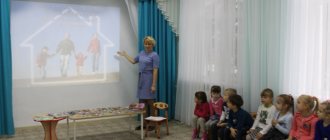Defining a project in school
Professor E.S. Polat, under the project method, considers a way to achieve a cognitive goal through a detailed study of the problem (technology), which will ultimately have a real, practical, appropriately designed result.
In his opinion, this is also a set of techniques, actions of designers in their specific sequence to achieve the task - solving a problem that is of particular importance for all participants in the process and must be expressed in the form of a specific product.
American teachers V. Kilpatrick and F. Parker formulated their definition: a project is an act of practical activity, which is based on the child’s target interest, the students’ consistent solution of life situations and problems.
Thus, working on a project is the practice of personally oriented learning in the process of the student’s specific work, based on his free choice, taking into account his interests.
Article: Classification of school projects
CLASSIFICATION OF SCHOOL PROJECTS
The project method is a teaching system in which students acquire knowledge in the process of planning and performing increasingly complex practical projects. This method is becoming increasingly popular among subject teachers.
Classification of projects can be carried out according to the timing of implementation, scale, quality of their development and implementation, location of implementation, and the size of the resources used. The variety of their species is extremely great in reality. The classification of projects has the following bases:
- Classification by subject area: monoprojects (within one academic subject), interdisciplinary, extracurricular.
- Classification by duration: mini-projects (one lesson or less), short-term (several lessons, usually from 2 to 4), long-term (for a quarter).
- Classification according to the place where students carry out projects: during lessons in the classroom, after lessons at school, at home, mixed.
- Classification by number of participants: individual, group, class.
1. A practice-oriented project is aimed at the social interests of the project participants themselves or the external customer. The product is predetermined and can be used in the life of a class, school, neighborhood, city, state. The palette is varied - from a teaching aid for the office to recommendations for restoring the Russian economy. It is important to evaluate the reality of using the product in practice and its ability to solve the problem.
2.The research project is structured like a truly scientific study. It includes justification of the relevance of the chosen topic, identification of research objectives, mandatory formulation of a hypothesis with subsequent verification, and discussion of the results obtained. In this case, methods of modern science are used: laboratory experiment, modeling, sociological survey and others. Research projects are one of the most common forms of this type of activity. 3. An information project is aimed at collecting information about some object or phenomenon for the purpose of analysis, generalization and presentation to a wide audience. The output of such a project is often publications in the media. The result of such a project may be the creation of an information environment for a class or school. Such projects are often integrated into research projects and become an organic part of them.
4. A creative project assumes the most free and unconventional approach to the presentation of results. These can be almanacs, theatrical performances, sports games, works of fine or decorative art, and videos.
5.Development and implementation of a role-playing project is the most difficult. By participating in it, designers take on the roles of literary or historical characters, fictional heroes. The result of such a project remains open until the very end.
Based on completeness, there are two types of projects.
1. Mono-projects. Conducted within the framework of one subject or one area of knowledge, i.e. performed on the material of a specific object. But they can use information from other areas of knowledge and activity. But the problem itself lies within the content of a specific subject area or area of human activity. Integration - at the stage of preparing a product for presentation: for example, a computer milestone of a product of project activity. Can be carried out within the framework of a class-lesson system. 2. Interdisciplinary (integrated) projects. They are performed exclusively outside of school hours and under the guidance of several specialists in various fields of knowledge. These can be small projects covering two or three subject areas, or they can be quite large and long-lasting. Sections (topics) of programs in different academic subjects are grouped around the project. An integrated project provides the opportunity to use knowledge in various combinations and blurs the boundaries between school disciplines; brings the application of school knowledge closer to real life situations. Projects also differ in the nature of contacts between participants:
– intraclass; – intra-school; – regional; – interregional; – international.
Bibliography
- O.E. Zhirenko, E.V. Lapina. Innovative teaching technologies in modern primary schools. Voronezh: 2010
- I.S. Sergeeva. How to organize project activities for students: A practical guide for employees of educational institutions. — 2nd ed., rev. and additional - M.: ARKTI, 2005. - 80 p. (Method, beep).
- Gerasimova O.V. Project activities in educational work / O.V. Gerasimova // Secondary vocational education-2006.
History of origin
The first mentions of the project method appeared in America in the 90s of the twentieth century. It all started with the pedagogical ideas and research of John Dewey (1859-1952). The scientist first introduced the term “project method” into the pedagogical process, gave its clear formulation, and justified the content.
School projects appeared in the USA
J. Dewey highlighted the main conceptual features of the project:
- the designer independently makes decisions in everyday matters through practical activities;
- the project participant develops creative abilities through collective activities;
- Each participant has a personal interest in the result of the work.
In 1905, a group of Russian scientists led by S. Shatsky conducted a study of the active introduction of design technologies into the pedagogical process. A little later, at the end of the 30s, this technique was recognized as “non-pedagogical”.
In the Soviet Union, project activities were not taken into account during the educational process, but were sometimes used in extracurricular activities, or in the form of student essays. Thus, the project method has a rather long history and a large number of developments by both Russian and foreign scientists.
Stages of work: from choosing a topic to presentation
Work on the project consists of three main stages:
Stage I – preparatory . At the first stage, participants choose a topic, justify its relevance, and formulate the problem of their research. No problem - no project.
Stage II – main stage . Direct implementation of the project:
- formation of groups, selection of research topics;
- work planning, distribution of responsibilities;
- selection of main sources of information, independent search work of designers;
- the work of group members on the implementation of the project, the selection of the most effective ways to present the finished product. Determination of the main criteria for assessing students.
Stage III is the final stage. Project protection, reflection.
What is an individual project
Depending on the form of implementation, projects can be individual or group. The type of each depends on the number of its participants.
The peculiarity of an individual project is that the work is completely carried out by one participant in accordance with his knowledge, desires, needs, and creative vision. The student is free to choose the basic principles and methods of solving the problem posed.
The child uses an individual type and style of work, self-learning skills, abilities for independent research work, as well as responsibility are actively developed, since the completion of the project depends solely on one student.
The student gains experience in performing all stages of the project - from the birth of the idea to the final reflection. The knowledge obtained in these conditions is more valid, its position is better reasoned.
The fundamental difference between an individual educational project is freedom. The designer is given the opportunity to independently deal with the problem that interests him, so he tries to cope with the difficulties that arise in the process of working on the project.
It is important that individual projects begin to introduce the project method in the classroom: in one of the lessons at the beginning of the year, students need to be told about the project method, what a project is, what types of projects exist, how it is possible to present the result of work on project, and provide the opportunity to make a creative project.
Senior group. Senior preschool age. Children 5-6 years old
Project “Acquaintance with the work of S. Ya. Marshak” in the senior group Target audience: preschool children, teachers, speech therapist of the compensatory group, parents. Implementation period: September 2020, short-term project . Project typology : educational, creative . The goal of the project : to introduce children to the creativity of S. I….
Cognitive and creative long-term project in the senior preschool group “Seasons” Efremenko N.L. teacher Efimtseva A.O. teacher MBDOU “Kindergarten No. 5 “Ivushka”
Educational
and creative long-term project “Seasons”,
Smolensk 2018-2019.
December-February 2018-2019 1. Water conversation with children on the topic: “Winter is coming.”
(conversation about winter and its...
Group projects
Group projects also have their benefits. During the implementation of such projects, the ability to achieve a common goal, understand a partner, understand one’s role in a group, resolve contradictions within a mini-team, negotiate with others and defend one’s own opinion is formed.
Groups independently determine what topic they will work on. Each creative group receives cards that present the necessary information, a specific problem and basic questions about the topic.
Group members independently distribute tasks and determine what will be the final product of the project. A schedule of consultations is developed with the teacher, who plays a coordinating role and directs the work of the group.
A situation of success is created, which contributes to the formation of a desire to work further. Thus, it is group projects that teach children to work as a single, cohesive team, support each other and help in everything.
How to properly design a project
Project activities are accompanied by documentation, which is a mandatory component. It is conventionally called “Project Passport”. Main components of the Project Passport:
| 1. | Project name | |
| 2. | Project type |
|
| 3. | The project team | Curator, team members. |
| 4. | Description of the project, problem | Problematic question. Relevance of the chosen research topic. |
| 5. | Ideal image | A brief description of what should ideally happen. |
| 6. | The purpose of this project | |
| 7. | Tasks |
|
| 8. | Expected results | Reporting documentation:
|
| 9. | Work planning | Areas of activity: 1, 2, 3 |
| 10. | Control, interim reports. | Individual conversations, intermediate reports in the form of homework, written tests. |
| 11. | Presentation of the finished product. | Multimedia presentation of results, scientific presentation, video. |
Research project at preschool educational institution
Research project in the preparatory group of a preschool educational institution
"Fluttering Flower"
1. Project type:
short-term, group
Type of project by composition of participants
– frontal.
2. Project goal:
attract children to the natural world; provide information about the life activity of butterflies, their structure, species; to foster cognitive activity in preschool children.
3. Tasks:
1. To form in children elementary ideas about the butterfly, its structure, methods of movement;
2. Foster a caring attitude towards living things;
3. Develop emotional responsiveness;
4. develop communication skills;
5. Develop research skills.
4.Relevance of the research topic.
While walking, the children saw a butterfly. Many children expressed admiration and genuine interest. There were some guys who offered to catch her, while others offered to just admire her. The children's opinions were divided. During the conversation, it turned out that many of the guys knew little about the butterfly. Thus, the questions arose: “How does a butterfly appear? What does it eat? Does it bring benefit or harm? Children's participation in the project will help them develop ideas about butterflies, their benefits or harm. Develop a caring attitude towards living things.
5. Expected results.
• Expanding and enriching children's knowledge about butterflies.
• Creation of a children's mini-museum with an activated subject-developmental environment in the group.
• Uniting children, parents and teachers in common creative activities.
• Fostering a sense of love for living things.
• Development of project content;
The World of Butterflies project was carried out in several stages.
First stage
- organizational and preparatory, at which a creative group is organized to create this project. The goals and objectives of the project are defined. The expected results of the project are outlined. In addition, fiction was selected, lesson notes on the surrounding world, musical works, outdoor games were developed, information on the topic “The World of Butterflies” was selected, and thematic planning for the project was drawn up.
A methodology for examining children’s knowledge and ideas about butterflies has been developed, and input diagnostics have been carried out using these methods.
Stage 2
— implementation of a project that involves directly conducting observations, conducting games, walks, and organizing artistic and creative activities for children. Collaborative work of children, parents and teachers on the topic of the project.
Stage 3
— the final one, which involves the creation of a mini-museum. Final diagnostics using developed methods to compare project results. Analysis of the results of project activities.
Project result
The results of the work carried out are the creation of a mini-museum “The World of Butterflies”.
What are the benefits of projects for schoolchildren?
School projects have many advantages:
- the approach to the learning process and its participants is radically changing: in this type of activity it is the student, and not the teacher, who is the key player;
- children’s research activities come first, rather than formal memorization and reproductive reproduction of information;
- bets are placed on the process itself, the acquisition and application of acquired knowledge;
- The characteristics of the physical, spiritual, moral, and mental development of the child’s personality must be taken into account.
In addition, in accordance with Article 13 of the UN Convention on the Rights of the Child, a child has the right to free expression, that is, “the freedom to seek, receive and impart information and ideas of any kind, regardless of frontiers, orally, in writing or in print, in works of art or through other means of the child’s choice.” Project activity is an excellent way to realize this right.
Another advantage of the project method is that students can apply the results of their activities in real life and find a practical purpose for them.
Working on a project teaches children to think independently, find and solve problems using knowledge from various fields, predict the results and possible consequences of different options for solving a problem, and establish cause-and-effect relationships.
Thus, the project method at school allows the simultaneous use of research, problem-solving and creative approaches. It promotes the all-round development of the child.
Children learn to work with information independently. This is very important today, since information resources are now in general use. Therefore, now it is very important to be able to correctly choose the main thing, weed out the secondary, analyze and draw conclusions.
In this video you will learn about the project activities of schoolchildren:
School projects: how to design correctly?
A school project is a student’s first scientific work. It is formatted in approximately the same way as other research works, in a somewhat simplified form.
Title page
Proper design of the title card is a big plus; it will immediately make a good impression and give additional points:
- At the top of the sheet, centered, write the full name of the educational institution indicating the locality.
- In the central part, also in the center, we write the topic of the work in an enlarged font. You can place a clear, bright picture under the title of the presentation.
- Below, right-aligned, we indicate the full name and surname of the author of the work: “Completed by student 3 “A” class Ivanov Ivan.”
- Under this line you need to write the teacher’s full name, place of work (school number). Right alignment. It should look like this: “Project manager: Maria Aleksandrovna Petrova, primary school teacher, Secondary School No. 100, Yakutsk.”
- At the very bottom of the sheet in the center is written the name of the locality and the year the project was completed.
Table of contents
The Contents section lists all sections in order (they are left aligned). In contrast, right-aligned, indicates the page on which the corresponding chapter begins. Dots are placed between the section title and its page in the table of contents. Please note: Each section below starts on a new page.
Goals and objectives
On the second page you need to indicate what goals and objectives are pursued by the work performed.
- The purpose follows from the topic that we indicated on the title page.
- Objectives are the actions the child took to achieve a goal. There should always be several of them, at least two.
Project body
The third sheet begins with the actual description of the research progress. It should be structured, and not be a continuous, continuous array of text.
Each task and the progress of its solution should be described in a separate paragraph (if they are small). If the tasks are larger, you can describe each one in a small subsection with a subtitle. Illustrations will be an additional plus. In addition, they further structure the text and make it more visual.
conclusions
After the job description is finished, you need to summarize. For this you need a “Conclusions” section. It starts on a new page. There are also several conclusions, as well as tasks. Each task must have its own outcome. Briefly, in one sentence we describe what we learned while solving this or that problem.
List of used literature
The list of books used is placed on the last page of the presentation. Book titles are listed in alphabetical order and must be complete. To correctly indicate the title of the book, it is best to copy it from the first page, where the output data is indicated. If the information was taken from websites, links to them should also be included in the list.
This is usually the sheet that presents the most difficulty. It is difficult for a child to correctly formulate complex names and organize everything. Therefore, some schools simplify the design of the last page. You need to learn more about this from the teacher. If difficulties arise, it also makes sense to approach the teacher in advance and ask for advice.
Source: https://zen.yandex.ru/media/id/5984d3e67ddde837f2a103e2/5cdab4d10ae27d00b35f0d1e




